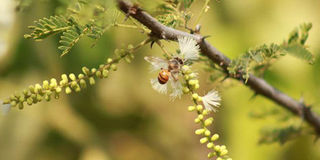Ecologist says bee population threatened by locust spraying

A bee on a flower. An ecologist has said that aerial spraying of locusts ravaging northern Kenya could lead to a massive decline in the population of bees and other insects. PHOTO | CHEBOITE KIGEN | NATION MEDIA GROUP
What you need to know:
- Mr Raini says the safety of useful insects like bees, ladybugs and earthworms, is jeopardised.
- He urges government to follow proper guidelines on aerial spraying.
- Bees help in pollination and a decline in their population may have a huge economic impact.
Aerial spraying of locusts ravaging northern Kenya could lead to a massive decline in the population of bees and other insects.
The government has been spraying the locusts in Samburu, Isiolo and Marsabit counties where pastoralism is a major source of income.
Environmentalist Jack Raini says the safety of useful insects like bees, ladybugs and squirmy old earthworms in the region is jeopardised by the massive spraying which has been ongoing for close to three months now.
This, he says, spells doom for pastoralist communities which depend on livestock and beekeeping as the insecticides can bring serious harm to cattle, animals and birds that may feed on the dead insects or the sprayed plants.
BE CAREFUL
“The government should be careful with aerial spraying because it can bring another disaster in the north. Important insects like bees in the forests can perish as a result of aerial spraying yet they are useful to the ecosystem,” said Mr Raini.
He also said that the spraying might lead to deaths of birds in forests in Samburu, Isiolo and Marsabit since they are likely to feed on the dead locusts.
Besides being a source of livelihood, bees help in pollination and a decline in their population may have a huge economic impact.
Mr Raini noted that it is dangerous to spray the insecticides openly and that government agencies in charge of aerial spraying should also be careful not to contaminate water bodies in the region.
PROPER GUIDELINES
He urged the government to follow proper guidelines on aerial spraying to avoid adverse effects from the chemicals. He also urged pastoralists and other residents to avoid areas that have been sprayed.
However, aerial spraying teams have denied that chemicals used on the locusts in the north are harmful to humans and the environment.
Samburu County special programmes chief officer, who is coordinating the aerial spraying, disputed the claims, saying thorough testing had been done to ascertain the success of the chemicals in killing locusts without affecting livestock, plants and residents.
FACTORS CONSIDERED
He said several factors are always considered, among them the size of a swarm, proximity to water bodies and settlement areas before doing aerial spraying.
“We are not spraying blindly. We always avoid densely populated areas and fresh water bodies. In densely populated areas and where the hopper bands have hatched, we apply ground spraying with the aid of NYS trainees,” he told the Nation.
He added: “There is no other means to control locust plagues other than using spraying.”





